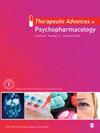Clozapine- and non-clozapine-associated neutropenia in patients with schizophrenia: a retrospective cohort study
IF 3.4
3区 医学
Q2 PHARMACOLOGY & PHARMACY
引用次数: 5
Abstract
Introduction: The antipsychotic drug clozapine remains underutilized partly because of the risk of life-threatening adverse effects, such as neutropenia. Therefore, an extensive hematological monitoring program was set up to detect neutropenia. Methods: In this retrospective cohort study, we used registry-based data from the Capital Region of Denmark to investigate incidence rates of neutropenia among patients with a diagnosis of schizophrenia or other psychotic disorders and treated with clozapine for the first time. In a within-subject design, we compared rates of neutropenia in time periods where patients were exposed to clozapine versus time periods, where they were not exposed to clozapine. We also investigated whether the lengths of clozapine-associated neutropenia (CAN) were related to discontinuation of clozapine treatment. Results: Data from 520 clozapine users were included. The incidence rate of CAN was 3.2 cases per 100 person-years (95% confidence interval [CI]: 2.1–4.8) throughout the entire study. There was no significant difference in incidence rates of neutropenia during clozapine exposure and non-clozapine exposure, with an incidence rate ratio of 0.7 (95% CI: 0.4–1.3). One episode of severe neutropenia was detected. Episodes of CAN with only one sub-threshold neutrophil count were not associated with higher clozapine discontinuation (26%) than CAN episodes of more than one sub-threshold neutrophil count (28%). Conclusion: In the present study, we could not confirm that clozapine treatment was associated with neutropenia.精神分裂症患者氯氮平和非氯氮平相关性中性粒细胞减少:一项回顾性队列研究
引言:抗精神病药物氯氮平仍然没有得到充分利用,部分原因是有危及生命的不良反应的风险,如中性粒细胞减少症。因此,建立了一个广泛的血液学监测程序来检测中性粒细胞减少症。方法:在这项回顾性队列研究中,我们使用丹麦首都地区基于登记的数据,调查首次接受氯氮平治疗的精神分裂症或其他精神病患者中性粒细胞减少症的发病率。在受试者内部设计中,我们比较了患者暴露于氯氮平的时间段与未暴露于氯喹的时间段的中性粒细胞减少率。我们还调查了氯氮平相关中性粒细胞减少症(CAN)的持续时间是否与氯氮平治疗的中止有关。结果:纳入520名氯氮平使用者的数据。CAN的发病率为3.2例/100 人-年(95%置信区间[CI]:2.1-4.8)。氯氮平暴露和非氯氮平暴露期间中性粒细胞减少症的发病率没有显著差异,发病率比率为0.7(95%CI:0.4-1.3)。检测到一次严重的中性粒细胞少症发作。只有一个亚阈值中性粒细胞计数的CAN发作与氯氮平停药率(26%)高于多于一个亚阈中性粒细胞数的CAN发作(28%)无关。结论:在本研究中,我们不能证实氯氮平治疗与中性粒细胞减少症有关。
本文章由计算机程序翻译,如有差异,请以英文原文为准。
求助全文
约1分钟内获得全文
求助全文
来源期刊
CiteScore
7.90
自引率
2.40%
发文量
35
审稿时长
10 weeks
期刊介绍:
Therapeutic Advances in Psychopharmacology delivers the highest quality peer-reviewed articles, reviews, and scholarly comment on pioneering efforts and innovative studies across all areas of psychopharmacology. The journal has a strong clinical and pharmacological focus and is aimed at clinicians and researchers in psychopharmacology, providing a forum in print and online for publishing the highest quality articles in this area.

 求助内容:
求助内容: 应助结果提醒方式:
应助结果提醒方式:


